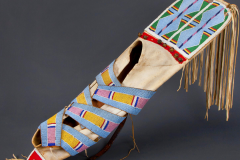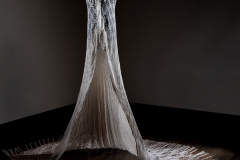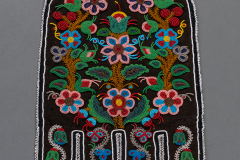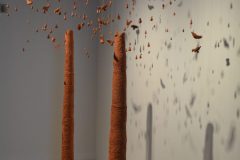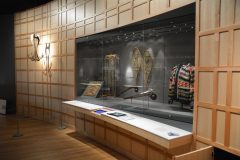Reinventing The Eiteljorg

Eiteljorg associate curator Dorene Red CloudPhoto by Emma Uber
Eiteljorg Museum associate curator Dorene Red Cloud talks about her tribe, allowing Native Americans to tell their own stories, and why the exhibits are now arranged in a totally new way.
What would you say is the biggest change to the Native American Galleries?
That it’s coming from Native American voices. The art and the artists are now the ones primarily telling the stories.
In what ways have you redesigned the exhibit to make sure that’s happening?
At the beginning of the exhibit, we have the land acknowledgement for the original peoples who call Indiana their homeland: the Miami, Delaware, Shawnee, Potawatomi, Kickapoo, and Peoria. That’s right before you get into the introduction space where we have speakers in the wall, and you’ll be welcomed by people from these tribes so you can hear the language. Some people are under the impression that Native languages are gone, but they’re not. They’re still in use. We’ve also done audio and video interviews with artists talking about their artwork. Then we have digital labels and digital hubs that will include photographs and biographies of the artists, along with links if they have their own website. This all contributes to one of our biggest exhibition goals, which is pointing out to people that Native peoples are still living. We’re still here.
What inspired this change?
In its last strategic plan, the museum came up with Project 2021 to redo the R.B. Annis Western Family Experience in the basement, the Clowes Sculpture Court—which is kind of like our ballroom upstairs—and the Native American Galleries on the second floor. The galleries had never been redone since the museum opened in 1989, so it was overdue.
When you started looking at a project of this magnitude, what were your first steps?
Working on a plan with our museum’s Native American Advisory Council was the first step. There was a core team from the Eiteljorg that started discussing big ideas. From there, we hired an exhibit design firm from Ottawa, Canada—Origin Studios. There were two gentlemen on their content team that worked with me, and we worked on the interpretative narrative plan. So it has taken a few years to go from initial conversations to the nitty gritty.
What was your biggest goal throughout the redesign process?
To make it a new and exciting place that everyone will want to visit, but also a place where our Native American community members will find themselves reflected.
Are you Native American yourself?
I am. I’m an enrolled member of the Oglala Sioux Tribe. I was born in Chicago, and my father was part of the federal relocation program from Pine Ridge, South Dakota to there, so my sister and I are what you would call “relocation kids,” or “urban Indians.” Because of the relocation program, which is one of the stories we tell in the exhibit, there are Native Americans all over the U.S. and Canada.
How has being Native American shaped your experience curating this exhibit?
It’s definitely been key because I feel like the inaugural exhibits were most likely curated by someone who wasn’t Native American. Not every Native person has the same experiences, but we do have similarities, and I feel like that insight is really what has guided the process and helped the project overall.

Photos courtesy Eiteljorg Museum
You made a big decision to reorganize the galleries thematically, rather than geographically or ethnographically. How did you arrive at that?
The original galleries were organized by geographic regions, which is becoming an outmoded way to introduce Native peoples to students. It teaches that these people lived here or there, but now with the influx of Native peoples to the cities and outside of reservations, it’s really more appropriate to let go of those old anthropological geographic regions and organize by theme. The themes are really to provide our visitors insight into what it is like to be a Native person, what it’s like to be a Native artist, what it’s like to be a contemporary member of society. More and more museums are realizing that Native peoples are the experts and authorities of their own stories. They have new ideas and ways to present art instead of just keeping to ethnographic 19th century explanations of “These are the people, this is what they wore, this is what they ate.” It’s no longer entirely focused on the past. It’s more like the focus is on now and the future.
The new themes are Relation, Continuation, and Innovation. Can you explain a little bit about what each of those represent?
Relation is about giving our visitors and people who are non-Native some insight into the spiritual beliefs and philosophies of many Native Americans—how they relate to others, the spiritual world, and to place. It’s also about our relation to animals and plants, because we don’t necessarily look at them as something to subjugate or conquer, but as a brother or sister or teacher. It’s really just trying to get people out of their own heads and look at how others view the world.
As for Continuation, many Native peoples of the U.S. and Canada have had similar experiences in the fact that they were forced to assimilate or acculturate. Despite some of these negative effects, such as boarding schools, Native cultures, spirituality, and artistic practices all still continue to this day. I wanted it to be less about “Oh, all these bad things happened to Native peoples and it’s over” because it’s not—the story is not over.
Innovation is a celebration of Native art and how, throughout time, Native artists have innovated different materials, even introduced them. Hundreds of years ago, Native artists would use porcupine quills. Then with the introduction of trade seed beads and various glass beads, they innovated with that to make glass beadwork, which is very popular. I think beads and feathers brings to peoples’ minds Native artwork, but Native artists of today are surpassing that and incorporating new methods. Really, anything is possible. One of the important things we do here is the Eiteljorg Contemporary Art Fellowship, which is a biannual program. Beginning this year, we’re going to award five contemporary Native artists $50,000 in an unrestricted cash award. We also purchase their art work and create a publication and exhibition about them. We’re one of the few museums in this country that offers that sort of fellowship for Native artists. So the purpose of Innovation is to incorporate contemporary Native art as well.
This multimedia redesign comes at a time when other local museums, such as Newfields, are also moving away from more conventional organization of their galleries. Is that a trend in the museum world?
Yes, we’re seeing that locally, regionally, and nationally. It’s a new century, and I think a lot has happened in the past few years to really get people thinking about wanting to respect and learn more about other people and to be open minded to new approaches in exhibit design and curation. So yeah, we’re going to see more of this.

With changes in exhibit design can come pushback. What is the biggest challenge you’ve encountered throughout the process of reimagining the Native American Galleries?
Some people just want to see the older stuff like arrowheads, headdresses, bead work, and that sort of thing. Overall, I think some people have this conception that Native art looks a certain way or is only authentic if it’s hundreds of years old. But if you think about it, Native artwork from hundreds of years ago was contemporary at the time. Another one of our goals is to have our visitors realize old and new Native art inform one other—you can’t have one without the other.
How do the redesigned galleries honor both that historic art and the new stuff?
We’re very lucky that our permanent collection has both. To help our visitors understand the connection, we incorporate both and show different examples over time to get people thinking “Oh, okay, this is all Native art.”
The exhibit has been closed for quite a while. What do you anticipate guests will be most surprised by upon their return?
I think the space. It’s beautifully designed. The graphics, the images, the digital hubs, the interactive and tactile places where you can touch beadwork or pottery or Seminole patchwork. I think it’s going to be a combination of those things. Towards the end of the exhibit, we have a video playing of six artist friends that we’ve interviewed talking about what it means to be a Native artist. One of the interviewees is a 12-year-old named Aydrian Day who is Hochunk, Ojibwe, and Lakota, and I just think a lot of kids are going to want to hear what he has to say.
Was appealing to audiences of different ages a goal?
That’s what we were gearing toward—creating a neurodiverse experience for all ages and abilities. We just want everyone to feel included and for things to be accessible. We took into account the different font sizes so it will be easier to read for those who may have visual impairments.
What’s the one big takeaway that you want visitors to leave with after viewing this new exhibit?
That Native peoples are still living, and all the art they create is “real art.” And that Native people are the authorities of their own stories.

